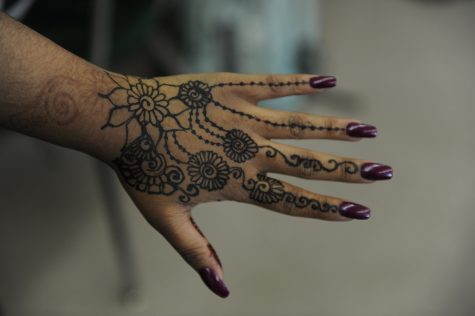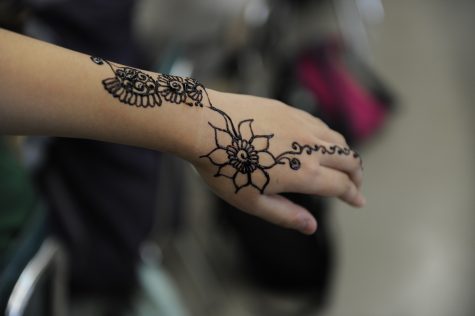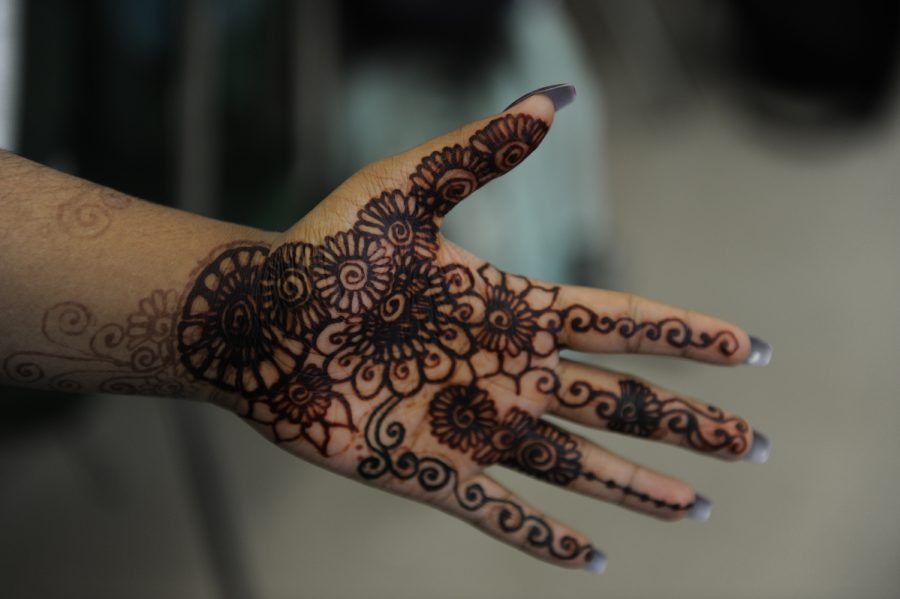“Hi. I’m Henna, I Don’t Think We’ve Met.”
A more traditional style of henna done by Rahma Tasnim ’19., using red henna. Black henna is also incorporated to add different details.
Henna tattoos, a trend that has been a mainstay of the festival and party scene during recent years, are being seen at many high profile events such as Coachella. While henna tattoos are something that have recently gained traction in the Western hemisphere, making them has been practiced for centuries all across the globe.
When the leaves of Lawsonia inermis plant are ground into a paste, it can be used as a dye known as henna, or mendhi, to stain or decorate. It dates back to 7000 B.C.E. when the rich and poor would use it to adorn their bodies in the place of actual jewelry.
For many, henna tattoos have been a way to express their love of their culture. “They aren’t just designs meant to adorn your body. It’s more than that. It is a way that I can express my love for my beautiful culture,” Fatema Kamal ’19 said.

A henna design done in black.
Henna is used to mark all kinds of celebrations. It is used to decorate the hands and feet before the wedding of a loved one and on the night before both Eid-ul-Fitr and Eid-ul-Adha to show the joy and beauty surrounding these occasions. For some, the holidays are often considered incomplete without the practice.
A common tradition to prepare for holidays or events is for the community to come and put on henna together as one. “To me, it’s a social activity of the purest kind. I see groups of women huddled on cushions in someone’s living room, talking and laughing and eating, all while making sure their designs don’t smudge,” Tahira Hasan ’19 said.
As students with South Asian heritage, henna holds a place in all of our hearts because it helps us hold onto our history. “In my culture, the girls and women apply henna to their hands and patiently leave it on for as long as possible. The reason behind this is that the darker it initially comes out, the more your significant other loves you. I find this little myth appealing because it’s a small piece of my culture that I can hold on to because it’s so benevolent,” said Helina Rathod ’19.
“People laughed at me, made jokes out of it, and one time an adult asked me if I got hurt. But now, everyone is covered in henna tattoos,” said Fatema Kamal ’19.
My sister’s mendhi night, a night or two before the wedding where the bride gets dolled up and her henna done, was full of laughs, food, and bright colors. The room was filled with pink and yellow flowers, gold and pink satin curtains, and groups of girls exceptionally dressed for the occasion. The decorative plates full of fruits and sweets were passed around the room and everyone took a piece with one hand, while the other was occupied getting its mendhi done. I remember girls practicing dances, putting on sarees, and stuffing their faces with food. These moments are unlike any other, as they connect us back to our roots and history.
Henna has evolved so that it is not just a way to celebrate moments and festivities, but also the artist’s creativity. While there are very traditional styles that are still practiced, many people have branched out to do more modern designs with the use of white and black henna. These products are not made from the traditional plant but are created chemically to produce these colored stains.

This photograph was taken immediately after the henna design was applied.
Personally, I love using different colors to create different styles on one design, because it allows for more creative fluidity in the art. For example, I will start off with a traditional tube of henna, because I want to use it for its consistency. Then, I would want it to be darker or lighter, so I would use a different stain, and the combination creates a unique design.
Starting to create designs and use henna is a newfound love. For many, it was difficult to appreciate its value and importance. “People laughed at me, made jokes out of it, and one time an adult asked me if I got hurt. But now, everyone is covered in henna tattoos,” said Fatema Kamal ’19.
It is important to recognize that many cultural practices are criticized and misunderstood at first, including henna, and just because it is slowly being accepted in the mainstream culture, does not mean that its history should be overlooked. To truly value and take part in cultural practices, like wearing henna, that are becoming more and more common in society, people should learn what wearing henna means.
Rahma Tasnim is a Staff Reporter for ‘The Science Survey’ and a Student Life Reporter on ‘The Observatory.’ She tends to write articles that relate...

